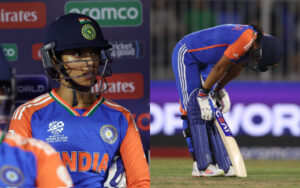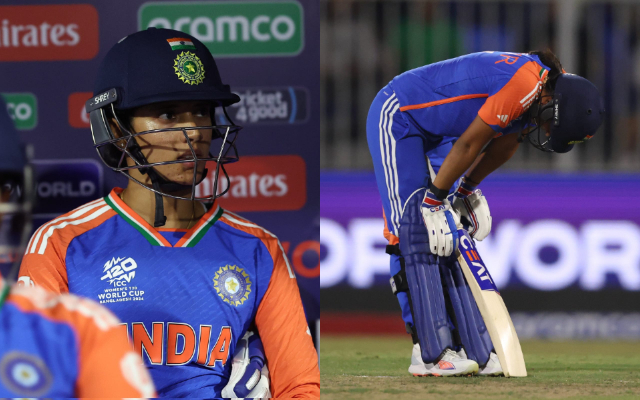
Snehasis Mukherjee in Sharjah
India suffered a nine-run defeat against Australia in their final group game of the ICC Women’s T20 World Cup at Sharjah Cricket Stadium. With only two wins from four matches, India are now almost out of the tournament. Chasing 152, skipper Harmanpreet Kaur’s unbeaten fifty was not enough to secure a victory. Here are the top five talking points from the match:
Bowlers conceding 150 runs in Sharjah
Sharjah is not where batters easily score 150-plus runs, as the pitch offers plenty of turn and grip. Some deliveries kept low, and Grace Harris had a tough time keeping them off her stumps. Despite these conditions, Australia batted brilliantly, posting 151/8 in 20 overs.
Bowlers like Shreyanka Patil and Arundhati Reddy conceded runs at an economy rate of eight, struggling to contain the Aussies. India’s leg-spinner Asha Sobhana was ruled out just before the match due to an injury, and her absence was sorely felt. After the loss, fans expressed disappointment, feeling that a more consistent bowling performance, particularly in line and length, could have restricted Australia to 15-20 runs less.
This was the first 150-plus score in Sharjah in this tournament, surpassing the previous best of 148/8 set by Australia against New Zealand.
Ordinary captaincy from Harmanpreet Kaur
On a pitch where the bowlers were getting turn, the ball was keeping low and gripping, India’s skipper Harmanpreet Kaur opted to use 10 overs of seamers. Surprisingly, Radha Yadav, a left-arm spinner, did not complete her full quota of four overs. She bowled just two overs, conceding 14 runs and taking the crucial wicket of Aussie captain Tahlia McGrath.
With so many right-handers in Australia’s middle-order, it seemed logical to use Radha, who was turning the ball away from them. However, Harmanpreet kept rotating her seamers and right-arm off-spinners, which failed to build any pressure on the opposition. Although India took eight wickets, Australia still managed to score at a rate of 7.50-plus on a tricky surface. This raised questions about the captain’s bowling decisions, especially given the conditions.
For the Latest Sports News: Click Here
🚨 5 Talking Points from India’s heartbreaking defeat against Australia in the last group stage game in the #T20WomenWorldCup2024.
A collective failure from the team! What all went wrong? @Fancricket12 and @snehasis_95 discuss! Share your thoughts 👇@OfficialFanatic #T20WC2024 pic.twitter.com/2gD4gyBB0f
— RevSportz Global (@RevSportzGlobal) October 14, 2024
Sloppy fielding efforts yet again
Statistically, India may be the best team in terms of catch efficiency globally, but the gap lies in their ground fielding and overall intent. India’s fielders were sloppy, with the skipper also dropping a straightforward chance. In contrast, Australia’s fielders threw their bodies around, saving singles and twos as if they were defending just 100 runs.
The Aussies’ intensity was evident as they chased every half-chance, trying to turn them into full opportunities. On the other hand, when the ball went up while India were fielding, their players seemed hesitant, often waiting for the ball rather than charging towards it. While Australia might have an edge in athleticism, the real difference is in mindset. To show better intent, you do not need to be more athletic — you need the right attitude, and that is where champion teams like Australia stand apart from the rest.
Smriti Mandhana’s failure in big matches
Smriti Mandhana is regarded as the best batter in this squad, but apart from her knock against Sri Lanka, this World Cup has been a disaster for her with the bat. The match against Australia was another chance for her to carry the momentum and perform when it mattered most, but once again, she failed. Unfortunately, this is not the first time.
In last year’s semi-final against Australia, the Commonwealth Games final against the same opponents, and now this match, Mandhana has struggled to deliver on the big stage. With repeated failures in crucial games, how can fans continue to believe in her? Some have even suggested she should be the next captain, but how can someone be given that responsibility when she has not performed in the most critical moments?
There are serious questions to be answered, and for Mandhana, time is running out. She is no newcomer, and as an experienced opening batter, if these failures continue, tough decisions may soon follow.

Amol Mazumdar’s post-match press conference
After the loss, head coach Amol Mazumdar attended the press conference and made an interesting point. He said: “We were right in the game till the last over. It was Australia’s experience that worked.” It is well-known that Australia’s experience on the big stage and their ability to win key moments have been formidable.
But the question remains; does not this Indian team have enough experience as well? With players like Harmanpreet, Deepti Sharma, and Mandhana, who have played numerous matches, the excuse of ‘experience’ appears unconvincing.
While it is true that India lack the experience of winning high-pressure games against top opponents, they have had plenty of opportunities, and this match was another. If they do not start capitalising on these chances, they will never gain that crucial experience, and more opportunities will continue to slip away.
Hence, many questions remain unanswered, and it is high time for introspection. India lost the Asia Cup final, and now they might not even be among the top four teams in the world. Where is this team heading? There seems to be no clear direction. If proper actions are not taken soon, fans will lose interest, and Indian women’s cricket risks falling into deeper disarray.
Also Read: Harmanpreet Recalls Sachin’s Desert Storm Ahead of Australia Showdown




